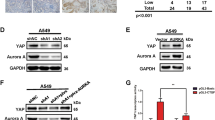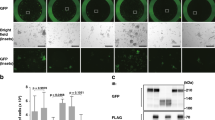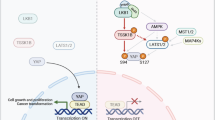Abstract
YAP (Yes-associated protein) oncogene has been found to form a stable complex with members of the Angiomotin (Amot) family of proteins, which bind WW domains of YAP and sequester the protein in the cytoplasm and junctional complexes. The Amot-mediated retention of YAP in the cytoplasm results in the inhibition of its proliferative function. Using apoptotic ‘read-out’ of YAP in HEK293 cells, we confirmed the molecular mode by which Amot regulates YAP. We showed that a representative member of the Amot family, AmotL1 (Angiomotin-like-1), uses its PPxY motifs to bind WW domains of YAP and inhibit YAP's nuclear translocation and pro-apoptotic function. Recently we also showed that YAP uses its PDZ-binding motif to interact with zona occludens-2 (ZO-2) protein, which promotes YAP's translocation to the nucleus. We also asked if AmotL1, YAP and ZO-2 signal together. We report here that AmotL1 and ZO-2 form a tripartite complex with YAP and regulate its function in HEK293 cells in opposite directions. AmotL1 inhibits pro-apoptotic function of YAP, whereas ZO-2 enhances it. As YAP is a potent oncogene, the identification and characterization of its regulators is important. AmotL1 and ZO-2 are two candidates that could be harnessed to control the oncogenic function of YAP.
This is a preview of subscription content, access via your institution
Access options
Subscribe to this journal
Receive 50 print issues and online access
$259.00 per year
only $5.18 per issue
Buy this article
- Purchase on Springer Link
- Instant access to full article PDF
Prices may be subject to local taxes which are calculated during checkout




Similar content being viewed by others
References
Basu S, Totty NF, Irwin MS, Sudol M, Downward J . (2003). Akt phosphorylates the Yes-associated protein, YAP, to induce interaction with 14-3-3 and attenuation of p73-mediated apoptosis. Mol Cell 11: 11–23.
Bratt A, Birot O, Sinha I, Veitonmaki N, Aase K, Ernkvist M et al. (2005). Angiomotin regulates endothelial cell-cell junctions and cell motility. J Biol Chem 280: 34859–34869.
Bratt A, Wilson WJ, Troyanovsky B, Aase K, Kessler R, Van Meir EG et al. (2002). Angiomotin belongs to a novel protein family with conserved coiled-coil and PDZ binding domains. Gene 298: 69–77.
Chan SW, Lim CJ, Chong YF, Pobbati AV, Huang C, Hong W . (2011). Hippo pathway-independent restriction of TAZ and YAP by angiomotin. J Biol Chem 286: 7018–7026.
Ehsanian R, Brown M, Lu H, Yang XP, Pattatheyil A, Yan B et al. (2010). YAP dysregulation by phosphorylation or DeltaNp63-mediated gene repression promotes proliferation, survival and migration in head and neck cancer subsets. Oncogene 29: 6160–6171.
Matallanas D, Romano D, Yee K, Meissl K, Kucerova L, Piazzolla D et al. (2007). RASSF1A elicits apoptosis through an MST2 pathway directing proapoptotic transcription by the p73 tumor suppressor protein. Mol Cell 27: 962–975.
Matsuda T, Cepko CL . (2007). Controlled expression of transgenes introduced by in vivo electroporation. Proc Natl Acad Sci USA 104: 1027–1032.
Nishimura M, Kakizaki M, Ono Y, Morimoto K, Takeuchi M, Inoue Y et al. (2002). JEAP, a novel component of tight junctions in exocrine cells. J Biol Chem 277: 5583–5587.
Oka T, Mazack V, Sudol M . (2008). Mst2 and Lats kinases regulate apoptotic function of Yes kinase-associated protein (YAP). J Biol Chem 283: 27534–27546.
Oka T, Remue E, Meerschaert K, Vanloo B, Boucherie C, Gfeller D et al. (2010). Functional complexes between YAP2 and ZO-2 are PDZ domain-dependent, and regulate YAP2 nuclear localization and signalling. Biochem J 432: 461–472.
Oka T, Sudol M . (2009). Nuclear localization and pro-apoptotic signaling of YAP2 require intact PDZ-binding motif. Genes Cells 14: 607–615.
Overholtzer M, Zhang J, Smolen GA, Muir B, Li W, Sgroi DC et al. (2006). Transforming properties of YAP, a candidate oncogene on the chromosome 11q22 amplicon. Proc Natl Acad Sci U S A 103: 12405–12410.
Pan D . (2010). The hippo signaling pathway in development and cancer. Dev Cell 19: 491–505.
Pei Z, Bai Y, Schmitt AP . (2010). PIV5M protein interaction with host protein angiomotin-like 1. Virology 397: 155–166.
Sowa ME, Bennett EJ, Gygi SP, Harper JW . (2009). Defining the human deubiquitinating enzyme interaction landscape. Cell 138: 389–403.
Strano S, Munarriz E, Rossi M, Castagnoli L, Shaul Y, Sacchi A et al. (2001). Physical interaction with Yes-associated protein enhances p73 transcriptional activity. J Biol Chem 276: 15164–15173.
Sudol M, Harvey KF . (2010). Modularity in the Hippo signaling pathway. Trends Biochem Sci 35: 627–633.
Sudol M . (2010). Newcomers to the WW domain-mediated network of the Hippo tumor suppressor pathway. Genes Cancer 1: 1115–1118.
Sugihara-Mizuno Y, Adachi M, Kobayashi Y, Hamazaki Y, Nishimura M, Imai T et al. (2007). Molecular characterization of angiomotin/JEAP family proteins: interaction with MUPP1/Patj and their endogenous properties. Genes Cells 12: 473–486.
Troyanovsky B, Levchenko T, Mansson G, Matvijenko O, Holmgren L . (2001). Angiomotin: an angiostatin binding protein that regulates endothelial cell migration and tube formation. J Cell Biol 152: 1247–1254.
Wang W, Huang J, Chen J . (2011). Angiomotin-like Proteins Associate with and Negatively Regulate YAP1. J Biol Chem 286: 4364–4370.
Yuan M, Tomlinson V, Lara R, Holliday D, Chelala C, Hanada T et al. (2008). Yes-associated protein (YAP) functions as a tumor suppressor in breast. Cell Death Differ 15: 1752–1759.
Zhao B, Li L, Lu Q, Wang LH, Liu CY, Lei Q et al. (2011). Angiomotin is a novel Hippo pathway component that inhibits YAP oncoprotein. Genes Dev 25: 51–63.
Acknowledgements
We thank Dr Makoto Adachi from Kyoto University in Japan for a kind gift of HA-tagged mouse Amot family plasmids and Priya Raghavan for experiments, which confirmed our initial observations. We also acknowledge members of the Sudol laboratory for helpful comments on the manuscript.
This research was supported by PA Breast Cancer Coalition grants (#60707 and #9200903) and by Geisinger Clinic.
Author information
Authors and Affiliations
Corresponding author
Ethics declarations
Competing interests
The authors declare no conflict of interest.
Additional information
Supplementary Information accompanies the paper on the Oncogene website
Supplementary information
Rights and permissions
About this article
Cite this article
Oka, T., Schmitt, A. & Sudol, M. Opposing roles of angiomotin-like-1 and zona occludens-2 on pro-apoptotic function of YAP. Oncogene 31, 128–134 (2012). https://doi.org/10.1038/onc.2011.216
Received:
Revised:
Accepted:
Published:
Issue Date:
DOI: https://doi.org/10.1038/onc.2011.216
Keywords
This article is cited by
-
YAP-mediated trophoblast dysfunction: the common pathway underlying pregnancy complications
Cell Communication and Signaling (2023)
-
ZNF582 overexpression restrains the progression of clear cell renal cell carcinoma by enhancing the binding of TJP2 and ERK2 and inhibiting ERK2 phosphorylation
Cell Death & Disease (2023)
-
ZO-2/Tjp2 suppresses Yap and Wwtr1/Taz-mediated hepatocyte to cholangiocyte transdifferentiation in the mouse liver
npj Regenerative Medicine (2022)
-
Effect of TDP43-CTFs35 on Brain Endothelial Cell Functions in Cerebral Ischemic Injury
Molecular Neurobiology (2022)
-
Molecular Alterations in Malignant Pleural Mesothelioma: A Hope for Effective Treatment by Targeting YAP
Targeted Oncology (2022)



